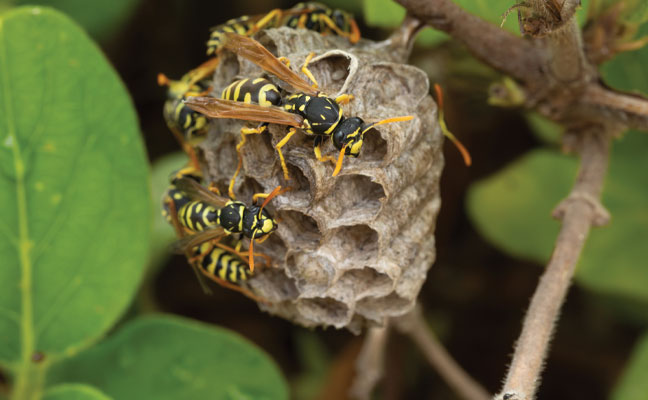
Normally, paper wasps (Polistes spp.) are among the more docile of the Hymenoptera insects that pest management professionals (PMPs) encounter. We locate the nest, knock out a few and go about our business. Even when they are nesting behind exterior shutters, a shot or two of an appropriately labeled pressurized aerosol does the trick. But sometimes, they can be challenging — especially at sensitive accounts.
RAILING AGAINST PAPER WASPS
At a well-known botanical garden, paper wasps were selecting a wooden handrail to remove small pieces of wood for nesting material. They were most active during the day when the sun was out. Unfortunately, the handrail was where visitors rested their arms while viewing a large pond containing very expensive koi. The koi were accustomed to being fed by humans, so they swam close to the handrails on the bridge. A few people were stung.
▶ Solution: Pesticides were out of the question, as the koi ran in the tens of thousands of dollars. The idea was not so much to kill the existing paper wasps, but to keep new ones from returning.
Why were they there? To seek nesting material. So, we changed the wooden handrail into a non-palatable product: plastic mimicking wood. The botanical garden team selected the color and design. Problem solved.
▶ Conclusion: The concern of the clients’ and the environmental issues took precedence over knocking off the insects. I refer to this as an “eco-change,” whereby the end result still looks great, but the dynamics of the target pest completely change.
HAPPY DUCKS, HAPPY CUSTOMER
Rare ducks were kept for breeding purposes and were intended for show. Each duck went into a small wooden house to deposit her eggs and care for them. This was all going on outdoors.
The problem was that paper wasps also wanted to nest on the inside roof of the structure. They kept flying in and out and disturbing the ducks.
The customer wanted to get rid of the wasps without harming the ducks or eggs.
▶ Solution: The rough interior roof of the structure was ideal for attaching wasp nests. With that in mind, smooth plastic was installed on each interior roof. This solved the nesting situation, but not entirely. The wasps were still attempting to enter and try to find a possible nesting site. To resolve this, a few nesting homes were built using the old rough roofing where the ducks did not enter. There, the wasps would go in and build their nests. Once a week, someone would go in and knock out any nests and wasps using an aerosol. This was done at night when the wasps were resting in their nests.
▶ Conclusion: Once you know why a pest is coming to an area, you can trick it into moving to where you want it to go.
Dr. Frishman, a PMP Hall of Famer (Class of 2002), can be reached at PMPEditor@northcoastmedia.net.
Leave A Comment